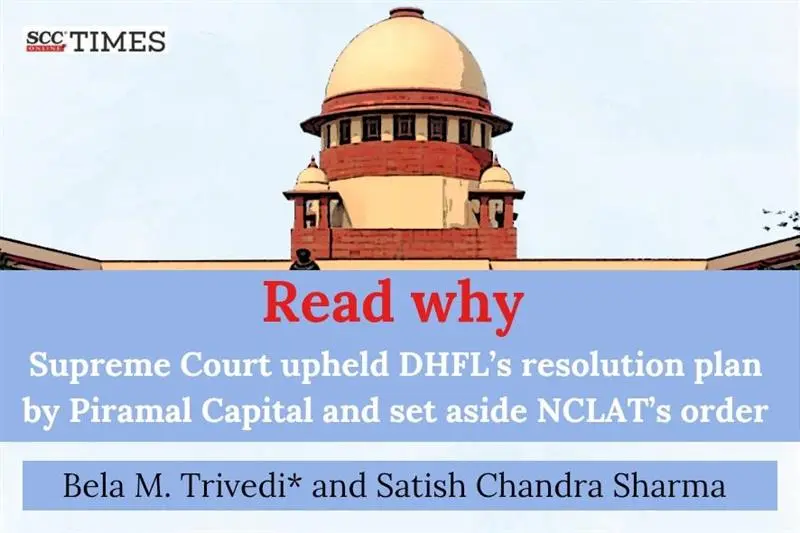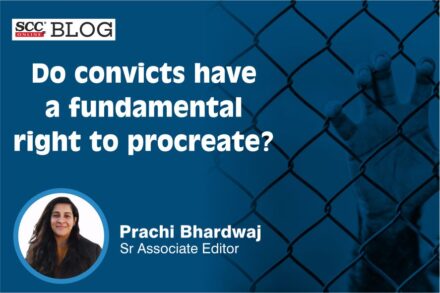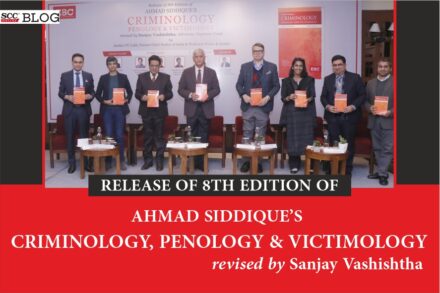Supreme Court: In a batch of civil appeals by Piramal Capital and Housing Limited (Piramal Capital) and others, Successful Resolution Applicant (SRA) against the common judgment passed by the National Company Law Appellate Tribunal, New Delhi, (NCLAT), only to the extent that it modified the Resolution Plan (RP) by holding that the RP that permitted the SRA to appropriate recoveries, if any, from Avoidance applications filed under Section 66 of the Insolvency and Bankruptcy Code, 2016 (IBC) ought to be set aside and the Resolution Plan be sent back to the Committee of Creditors (CoC) for reconsideration on that aspect, the Division Bench of Bela M. Trivedi* and Satish Chandra Sharma, JJ. set aside the impugned decision holding that the RP approved by the CoC was an outcome of the commercial bargain struck between the SRA and the CoC after several rounds of negotiations and deliberations. The said plan approved by the CoC was also further approved by the NCLT under Section 31(1) of IBC. In absence of any perversity, that was palpable on the face of the approved RP, and the CoC having taken a firm commercial decision with regard to the impugned clause of RP by voting overwhelmingly in favour of the RP, the NCLAT ought not to have interfered with the said clause of RP approved by the CoC and the NCLT.
The Court upheld the NCLT’s decision granting its approval to the Plan Approval Application, and thereby approving the Resolution Plan. The Court clarified and directed that the NCLT shall decide the Avoidance Applications filed by the Administrator under Section 43, 45, and 50, and shall separately decide the Applications under Section 66, and it shall pass the orders in accordance with the powers conferred upon it under Section 44, 48, 49, 50, and under Section 66, as the case may be. The recoveries/benefits that may follow from such Applications shall be appropriated in favour of the CoC in case of Avoidance Applications under Sections 43, 45, and 50, and in favour of SRA-Piramal Capital in case of Applications under Section 66 of the IBC.
Background
The DHFL was a housing finance company and a non-banking financial company, engaged in providing housing finance services to retail customers, including under the Pradhan Mantri Awas Yojana and certain project loans, mortgage finance, and construction loans. The DHFL had, for conducting its business availed financial assistance through a range of instruments including inter alia rupee loans, external commercial borrowings, non-convertible debentures, perpetual debentures, subordinate debt, public deposits etc. from banks, financial institutions, other lenders like insurance companies, mutual funds, provident funds, pension funds and individuals. The DHFL was accused of committing one of India’s biggest financial scams, worth thousands of crores of rupees, involving accusations of loan fraud, money laundering, creating web of fake borrowers and shell companies, etc.
Eight applications were filed before the NCLT regarding the preferential, undervalued, and extortionate transactions, and the applications with regard to the fraudulent and wrongful trading. The said applications are pending for adjudication by the NCLT. The total amount involved in the avoidance applications pending before the NCLT is about Rs. 45,050/- Crores.
The NCLT vide its Order dated 19-05-2021 allowed the plea filed by the erstwhile Director and directed the Administrator to place the 2nd Settlement Proposal before the CoC for consideration and voting within 10 days. The Administrator, CoC, and Piramal filed appeals under Section 61 of the Code before the NCLAT challenging the said order. The NCLAT, while issuing notice, stayed the NCLT.
The Civil Appeal (C.A.) Nos.1632-1634 of 2022 were filed by the SRA – Piramal Capital, and C.A. Nos.2989-2991 of 2022 were filed by the Union of India, challenging the impugned judgment to the extent the NCLAT modified the RP and the C.A. Nos. 3694-3695 of 2022 were filed by the 63 Moons to the extent the NCLAT sent back the RP to CoC for reconsideration. The NCLAT vide the said impugned order set aside the term in the RP that permitted the SRA to appropriate recoveries, if any, from avoidance applications filed upon Section 66 of the IBC, and sent back the RP to CoC for reconsideration on that aspect.
Issue
Whether the RP in question approved by the CoC and the NCLT was in contravention of the provisions of any law, for the time being in force, requiring the NCLAT to exercise its jurisdiction under Section 61 of the IBC?
Analysis and Decision
Regarding avoidance applications, the Court pointed out that one of the duties statutorily cast upon the Resolution Professional in Clause (j) of Section 25(2) of the IBC is that the Resolution Professional shall file an application for avoidance of transactions in accordance with Chapter III, if any. Having regard to the said Chapter III, which pertains to “Liquidation Process,” it appears that there are three types of applications that could be filed by the Resolution Professional for avoidance transactions. (i) Application for avoidance of Preferential transactions under Section 43, (ii)Application for avoidance of Undervalued transactions under Section 45, and (iii) Application for avoidance of Extortionate Credit transactions under Section 50. Section 26 specifically states that the filing of an Avoidance Application under Clause (j) of sub-section (2) of Section 25 by the Resolution Professional shall not affect the proceedings of CIRP.
Avoidance Applications
The Court added that there is a clear distinction between the Avoidance Applications that may be filed by the Resolution Professional in view of Section 25(2)(j), for avoidance of transactions in accordance with Chapter III of the IBC, and the Applications that may be filed by the Resolution Professional in respect of the fraudulent trading or wrongful trading under Section 66, which falls under Chapter VI of the IBC.
“The legislature has consciously kept the Applications in respect of Fraudulent trading or Wrongful trading falling in Chapter VI, outside the purview of Section 25(2), which requires the Resolution Professional to undertake the actions and file applications for the avoidance of transactions in accordance with Chapter III. Both the Avoidance Applications under Chapter III and the Applications in respect of Fraudulent trading or Wrongful trading under Chapter VI, operate in different situations. The powers of the Adjudicating Authority in respect of the Avoidance Applications filed under Chapter III and the powers of the Adjudicating Authority in respect of the Applications pertaining to the Fraudulent and Wrongful trading filed under Chapter VI, have also been separately circumscribed.”
The Court noted that in cases of “Fraudulent or Wrongful trading” in respect of the business of the CD as contemplated in Section 66 of the IBC, the properties and the persons involved may or may not be ascertainable and therefore the Adjudicating Authority is not empowered to pass orders to avoid or set aside such transactions, but is empowered to pass orders to the effect that any persons, who were knowingly parties to the carrying on of business in such manner, shall be liable to make such contributions to the assets of the CD, as it may deem fit. In case of fraudulent trading or wrongful trading, it would be a matter of inquiry to be made by the Adjudicating Authority as to whether the business of CD was carried on with intent to defraud creditors of the CD or was carried on for any fraudulent purpose.
Hence, considering the same, the Court said that the applications filed in respect of “Fraudulent and Wrongful trading” carried on by the CD, could not be termed as “Avoidance Applications” used for the applications filed under Sections 43, 45 and 50 to avoid or set aside the Preferential, Undervalued or Extortionate transactions, as the case may be. The Court explained that if the RP has filed common applications under Sections 43, 45, 50 and also under Section 66, the Adjudicating Authority shall have to distinguish the same and decide as to which provision would be attracted to which of the applications, and then shall exercise the powers and pass the orders in terms of the provisions of IBC.
Mandatory Requirements of Section 30(2) of the IBC and Regulation 38 of IBBI (Liquidation Process) Regulations, 2016
The Court elaborated that the entire process, right from the submission of RPs by the Prospective Resolution Applicants (PRAs) till the final approval/rejection of the Plan by the Adjudicating Authority has been duly prescribed, which is mandatory in nature. If there is any non-compliance with the mandatory requirements stated in Section 30(2) of the IBC, read with Regulation 38 of the Regulations, 2016, the Adjudicating Authority is empowered to reject the plan as envisaged in Section 31(2). If, however, the plan approved by the CoC as per Section 30(4) meets the requirements under Section 30(2), the Adjudicating Authority has to approve such a plan under Section 31(1), which would be binding to all the stakeholders as stated therein.
Maximization of the value of the assets of the Corporate Debtor
In CIRP, the role of the CoC is that of a protagonist, who takes the key decisions in its commercial wisdom and also takes the consequences thereof. The decisions of CoC must reflect the fact that it has taken into account the maximization of the value of the assets of the CD, and that the interest of all the stakeholders has been adequately balanced.
The “maximization of the assets” has not been defined in the IBC. Regulation 37 of the Regulations, 2016, states that RPs shall provide for the measures as may be necessary for insolvency resolution of the CD, for maximization of the value of its assets, which may include the measures as provided in Clauses (a) to (l) thereof. The Preamble of IBC envisages “maximization of the value of the assets of the Corporate Debtor.”
The Court pointed out that the financial layout and the measures proposed for maximization of the value of the assets of the CD has to be placed before the CoC. Further, the Court added that the CoC, if after considering such measures for maximization of the value of the assets of the CD as proposed by the RA in the RP submitted by it, and considering the feasibility, viability and such other requirements as mandated in the IBC and the Regulations, 2016, approves the plan with the requisite number of votes as required under Section 30(4), after exercising its commercial wisdom, then the scope of judicial review by the Adjudicating Authority under Section 31 will be limited only to the extent of satisfying itself about the compliance of the requirements of Section 30(2). The judicial review by the Appellate Authority under Section 61 in the appeal against the order of the Adjudicating Authority approving the plan is limited to the grounds mentioned in Clauses (i) to (v) specified in Section 61(3).
NCLAT’s stand of entertaining the appeals filed by the respondent and interference with the RP approved by the CoC and NCLT, by tinkering with the isolated clauses of the approved RP
NCLAT’s approach of entertaining the appeals at the instance of the appellants before the NCLAT 63 Moons and Roopjyot Engineering Private on the ground that the SRA could not have appropriated the recoveries from the Avoidance Applications under Section 66 IBC, and that the NCLT while approving the RP had not decided whether the recoveries in respect of the avoidance transactions vested with the CD, should be applied for the benefit of the creditors of CD, SRA or other stakeholders, was termed as not only ex facie fallacious and erroneous by the Court but also in utter disregard of the legal position settled by this Court in catena of decisions.
The Court noted that the appellants’ respective classes (before NCLAT) had voted overwhelmingly in favour of the RP of SRA. Neither the 63 Moons nor Roopjyot had voted against the RP, nor was any justification offered by them for not voting against the RP. Hence, the Court laid down that the NCD Holders before the NCLAT were bound by the decision of their classes in approving the RP, and were estopped from raising any objection against the RP approved by the CoC.
The Court stated that the vote cast by the authorized representative of the class of financial creditors is a vote on behalf of each financial creditor to the extent of his voting share. Once the said process is carried out and the authorized representative is handed down a particular decision by the requisite majority of voting shares, he has to vote accordingly, and his vote would bind all the financial creditors he represented.
If the finality and binding force is not provided to the votes cast by the Authorized Representatives of a class of Financial Creditors, a plan of resolution involving large number of parties may never fructify. In the instant case, the vote cast by the Authorized Representative -Catalyst Trusteeship on behalf of the class of Financial Creditors he represented, was binding on the 63 Moons and other Appellants before the NCLAT, and therefore they were estopped from raising any objection before the NCLT or NCLAT against the RP approved by the requisite majority of CoC.
Additionally, the Court said that the reliance on Regulation 37A of the Liquidation Regulations by the NCLAT was also thoroughly misplaced for holding that the said Regulation empowered a Liquidator to assign or transfer a non-realisable asset during the liquidation of a CD, however, such provision is absent in the CIRP Regulations, 2016.
The Court held that the NCLAT transgressed its jurisdiction under Section 61 of the IBC by interfering with the clause pertaining to the treatment of recoveries from the fraudulent and wrongful trading under Section 66.
Whether the resolution plan violated the provisions of RBI act or NHB Act?
The Court held that none of the provisions (Section 36(A) of the NHB Act; Section 45 (QA) of the RBI Act) mandates full payment of deposits or confers any right upon the depositors to have full payment of such deposits. The Court noted that there was nothing on record to suggest that any authorised officer under the NHB Act or the CLB under the RBI Act passed any order to make full payment of deposits to the appellants. Hence, by any stretch of imagination, the RP in question, providing for the distribution mechanism, was not contrary to any of the provisions of the RBI Act or of the NHB Act.
Conclusively, the Court held that when majority of the creditors in their wisdom, and after negotiations with the PRA as to how and in what manner the Corporate Resolution Process should be undertaken, had explored the feasibility and viability of the RP, while approving the same, and when the said Plan was also approved by the NCLT, the NCLAT ought not to have tinkered with a Clause of the said Plan with regard to the treatment of Recoveries from the applications under Section 66 of the IBC.
[Piramal Capital & Housing Finance Ltd. v. 63 Moons Technologies Ltd., 2025 SCC OnLine SC 690, decided on: 01-04-2025]
*Judgment Authored by: Justice Bela M. Trivedi
Advocates who appeared in this case :
For Parties: Mr. Satish Kumar, AOR Ms. Misha Rohatgi, AOR Mr. M. Yogesh Kanna, AOR Mr. Mahfooz Ahsan Nazki, AOR Mr. Divyam Agarwal, AOR Mr. Tushar Mehta, Solicitor General Mr. Navin Pahwa, Sr. Adv. M/S. Cyril Amarchand Mangaldas, AOR Mr. Rhishabh Jetley, AOR Mr. Kapil Sibal, Sr. Adv. Mr. Gagan Gupta, Sr. Adv. Mr. E. C. Agrawala, AOR Dr. Abhishek Manu Singhvi, Sr. Adv. Mr. Balbir Singh, Sr. Adv. Mr. Jasmeet Singh, AOR M/S. Juris Corp., AOR Mr. Nakul Dewan, Sr. Adv. M/S. Cyril Amarchand Mangaldas Aor, AOR Ms. Misha Rohatgi, AOR Mr. Jasmeet Singh, AOR Mr. E. C. Agrawala, AOR Mr. Raghavendra P. Shankar, A.S.G. Mr. Navneet R., AOR Mr. Deepak Prakash, AOR Mr. Manu Shanker Mishra, AOR Mr. Vedant Singh, AOR Mr. Chand Qureshi, AOR 4 Mrs. Taruna Singh Gohil, AOR Mr. Pranav Sachdeva, AOR Mr. Deepak Prakash, AOR Mr. Subhro Sanyal, AOR Mr. A. Lakshminarayanan, AOR Ms. Sugandha Anand, AOR Mr. Tarun Gupta, AOR Ms. Harsh Lata, AOR Ms. Bharti Tyagi, AOR Mr. Shivaji M. Jadhav, AOR Ms. Deepanwita Priyanka, AOR






